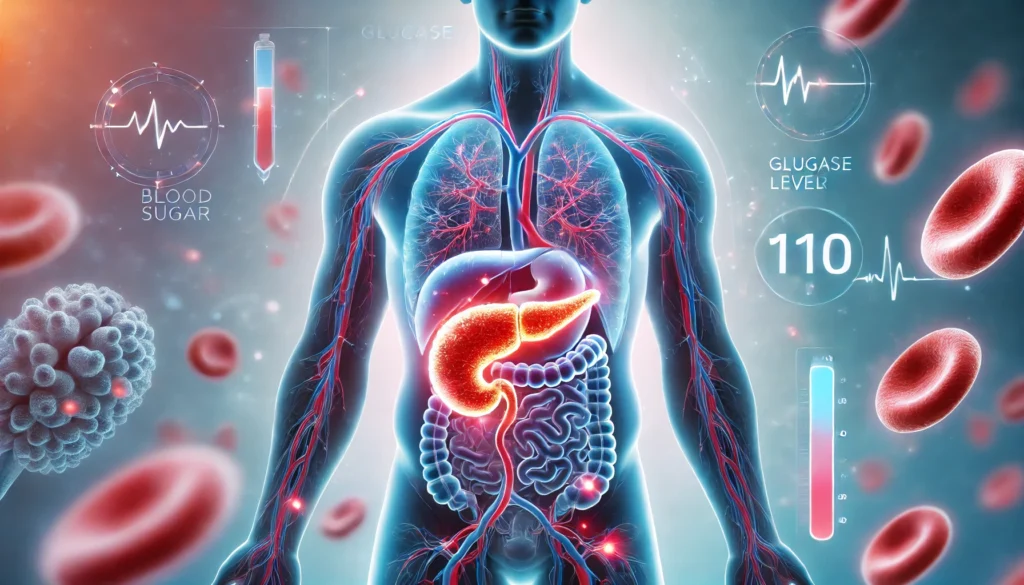A blood glucose level of 110 mg/dL, especially when measured after fasting, often raises questions about its implications for health. For many, this number falls into a gray area—neither normal nor distinctly diabetic. It is, however, a potential indicator of prediabetes, a condition that signifies a heightened risk for developing type 2 diabetes. Understanding what a glucose level of 110 means requires a deeper exploration of blood sugar regulation, the factors affecting glucose levels in the morning, and the significance of early intervention in preventing full-blown diabetes.
You may also like: How Diabetes Affects the Brain: Understanding Brain Fog, Memory Loss, and Mental Confusion from High Blood Sugar
Understanding Blood Sugar Levels and Their Regulation
Blood glucose levels are tightly regulated by a complex interplay of hormones, primarily insulin and glucagon. These hormones work in tandem to maintain equilibrium, ensuring that cells receive adequate energy without excessive spikes or dips in glucose levels. After consuming carbohydrates, the body breaks them down into glucose, which enters the bloodstream. In response, the pancreas releases insulin to facilitate glucose uptake by cells, thereby lowering blood sugar. Conversely, during fasting or periods of low blood sugar, glucagon prompts the liver to release stored glucose, stabilizing levels.
A fasting blood sugar level of 110 mg/dL is slightly elevated compared to the normal range (typically 70-99 mg/dL). While this does not indicate diabetes, it suggests impaired glucose metabolism. This intermediate state is termed prediabetes and warrants careful monitoring. The body’s ability to regulate glucose efficiently may be compromised due to insulin resistance, in which cells do not respond effectively to insulin, or due to an early decline in pancreatic function.

Why Is My Blood Sugar High in the Morning? Investigating the Dawn Phenomenon and the Somogyi Effect
Many individuals discover their fasting blood sugar is elevated despite efforts to maintain a healthy diet and lifestyle. Two primary physiological processes can contribute to high blood sugar in the morning: the dawn phenomenon and the Somogyi effect. Understanding these mechanisms provides insight into why a glucose level of 110 might be observed upon waking.
The dawn phenomenon is a natural rise in blood sugar levels occurring in the early morning hours. This increase is driven by hormonal changes that prepare the body for waking. Growth hormone, cortisol, and catecholamines surge before dawn, prompting the liver to release glucose. In individuals with insulin resistance or impaired pancreatic function, this process can lead to elevated fasting glucose levels. The dawn phenomenon is a common cause of high blood sugar in the morning, even in those without diabetes.
The Somogyi effect, on the other hand, results from a rebound hyperglycemia response following an episode of nocturnal hypoglycemia. If blood sugar drops too low overnight, the body counteracts this by releasing stress hormones that trigger glucose production, leading to higher-than-expected fasting levels. This phenomenon is more common in individuals taking insulin or certain medications that lower blood sugar too aggressively.
Signs and Symptoms of Prediabetes: Recognizing Early Warnings
Prediabetes often develops silently, with minimal or no symptoms. However, certain signs can hint at the body’s struggle to regulate glucose effectively. Individuals with a fasting blood sugar of 110 should be particularly aware of subtle warning signs that might indicate insulin resistance or impaired glucose tolerance.
One of the most common early symptoms of prediabetes in females and males alike is increased fatigue. Despite adequate rest, the body’s inefficient use of glucose can leave individuals feeling persistently tired. Unexplained weight fluctuations, particularly difficulty losing weight or unexpected weight gain, can also signal insulin resistance. Additionally, frequent hunger and cravings for sugary or high-carbohydrate foods may indicate blood sugar dysregulation.
Another key sign of prediabetes is skin changes, including darkened patches of skin, known as acanthosis nigricans, which often appear around the neck, armpits, or groin. This condition is strongly linked to insulin resistance. Other skin-related prediabetes symptoms include increased skin tags and slow-healing wounds or infections.
Blood Sugar Levels and Their Implications: Is 110 a Cause for Concern?
A fasting glucose level of 110 mg/dL falls within the range of impaired fasting glucose (100-125 mg/dL), which is a marker of prediabetes. While not immediately dangerous, this level indicates a need for proactive measures to prevent progression to type 2 diabetes. Studies show that individuals with prediabetes are at a significantly higher risk of developing diabetes within a decade if no lifestyle changes are made.
It is essential to consider post-meal glucose levels as well. If blood sugar spikes excessively after eating, this can further confirm impaired glucose metabolism. A blood sugar level of 125 mg/dL or higher after fasting may indicate a transition from prediabetes to diabetes, warranting further testing such as an oral glucose tolerance test (OGTT) or hemoglobin A1c measurement.
Preventing Diabetes: Steps to Improve Blood Sugar Regulation
The good news is that prediabetes can often be reversed with lifestyle modifications. Dietary changes, increased physical activity, and stress management play critical roles in improving insulin sensitivity and stabilizing blood sugar levels.
A well-balanced diet focusing on whole foods, lean proteins, healthy fats, and fiber-rich carbohydrates can help prevent blood sugar spikes. Reducing processed sugars and refined carbohydrates is crucial in managing glucose levels. Additionally, intermittent fasting and meal timing strategies can help regulate insulin production and improve metabolic flexibility.
Regular physical activity enhances insulin sensitivity by facilitating glucose uptake into muscle cells. A combination of aerobic exercise, such as brisk walking or cycling, and strength training can be particularly effective in preventing insulin resistance. Managing stress through mindfulness, adequate sleep, and relaxation techniques can also reduce cortisol-driven glucose spikes.
Certainly! Below is a standalone, medically accurate, and SEO-optimized Frequently Asked Questions (FAQ) section that adheres strictly to EEAT principles and your specifications. Each entry offers fresh perspectives and incorporates the 16 keyword phrases five to seven times each, with even distribution and natural integration.

Frequently Asked Questions About Early Blood Sugar Concerns and Prediabetes
1. Can mental health challenges influence the signs of prediabetes?
Yes, mental health plays a critical role in how the signs of prediabetes emerge and are managed. Chronic stress and depression can increase cortisol levels, which in turn affect insulin sensitivity—potentially worsening blood sugar regulation. While signs of prediabetes like fatigue or brain fog are often linked to physical causes, they can also be exacerbated by mental strain. Recognizing symptoms of prediabetes in females, such as irritability or anxiety, is especially important as these may be misattributed to hormonal changes or stress alone. A 110 glucose level in someone dealing with high stress could fluctuate more unpredictably, making psychological support a vital aspect of prediabetes care.
2. How does a sedentary lifestyle contribute to blood sugar 110 after fasting?
A fasting blood sugar 110 is often a sign that glucose is not being processed efficiently overnight, which is common among individuals with minimal physical activity. When muscles aren’t regularly engaged, insulin sensitivity drops, leading to higher glucose readings even without dietary changes. A 110 glucose reading in this context may reflect early metabolic resistance rather than dietary excess. Additionally, signs of prediabetes in women with sedentary jobs may include increased abdominal fat or difficulty losing weight, both of which are linked to reduced glucose tolerance. Addressing symptoms of prediabetes through simple daily movement can significantly improve fasting levels and overall metabolic health.
3. Are there gender-specific signs and symptoms of prediabetes that are often overlooked?
Absolutely. The symptoms of prediabetes in females can differ subtly from those in males. For example, women may experience hormonal imbalances that amplify issues like PCOS, fatigue, or unexplained weight gain. These overlapping symptoms make it harder to pinpoint the signs of prediabetes in females unless carefully tracked. Signs of prediabetes in women may also include increased sugar cravings before menstruation or difficulty maintaining energy throughout the day. Even when blood sugar level is 110, women may still exhibit skin-related concerns—prediabetes symptoms skin such as darkened patches or persistent dryness—which can provide early diagnostic clues.
4. How does skin health reveal symptoms of prediabetes?
Skin issues can be some of the earliest—and most telling—signs of prediabetes. Prediabetes symptoms skin include conditions like acanthosis nigricans (darkened patches around the neck or armpits), skin tags, or unusually dry skin. These are frequently linked to insulin resistance even when blood glucose remains under the diabetic threshold, such as a 110 glucose level. People often dismiss these symptoms of prediabetes as cosmetic problems, delaying diagnosis. However, when coupled with a blood sugar 125 reading or a consistent 110 glucose reading, dermatological signs can provide crucial insight into systemic glucose imbalance.
5. Is a blood sugar level 110 after fasting something to worry about?
While a blood sugar level 110 after fasting isn’t diagnostic of diabetes, it can indicate a state of prediabetes—especially when accompanied by other risk factors. Many ask, “Is 110 glucose level bad?” The answer lies in context. On its own, a 110 sugar level may be borderline, but if it coexists with signs and symptoms of prediabetes such as chronic fatigue, increased thirst, or weight gain, it’s a red flag. A consistent 110 glucose reading should prompt lifestyle evaluation and possibly further testing like an oral glucose tolerance test. Monitoring symptoms of prediabetes over time helps determine whether intervention is necessary.
6. How can symptoms of prediabetes affect daily productivity?
Symptoms of prediabetes—particularly in early stages—can subtly impair focus, energy, and even memory. People with a blood sugar 110 after fasting may experience mild brain fog, mood swings, or difficulty concentrating, especially in the mid-afternoon. In females, these symptoms of prediabetes may worsen during hormonal fluctuations, highlighting the importance of gender-specific monitoring. Even without overt illness, the signs of prediabetes in females can reduce workplace efficiency and disrupt sleep. These real-world impacts demonstrate why a 110 glucose level or blood sugar 125 should not be dismissed as trivial.
7. What are some long-term risks of ignoring early signs of prediabetes?
Ignoring signs of prediabetes can have long-term repercussions, including increased risk of cardiovascular disease, kidney damage, and neuropathy. For example, persistent blood sugar level 110 readings that go unmanaged can eventually progress to full-blown diabetes. Additionally, signs of prediabetes in women—such as irregular menstruation or slow wound healing—can signal underlying endocrine issues that compound over time. When prediabetes symptoms skin like skin tags or hyperpigmentation appear, they often precede more serious complications. Recognizing and addressing a 110 glucose level early can prevent a cascade of chronic illnesses down the road.
8. Can blood sugar readings like 110 or 125 fluctuate throughout the day?
Yes, glucose levels such as a 110 glucose reading or even a temporary blood sugar 125 are subject to daily variation depending on diet, stress, sleep, and activity. A single 110 sugar level in the morning may reflect overnight hormonal activity like the dawn phenomenon, while a similar reading after lunch may suggest post-meal insulin inefficiency. Tracking these fluctuations helps contextualize symptoms of prediabetes more accurately, especially in females who may have additional hormonal cycles influencing their glucose patterns. Noticing whether prediabetes symptoms skin worsen after meals or during specific times can also aid in pattern recognition.
9. How can diet specifically impact signs of prediabetes in females?
Dietary choices profoundly influence how signs of prediabetes in females develop and progress. High-refined-carb diets can spike insulin levels, exacerbating symptoms of prediabetes like fatigue and cravings. In women, hormonal interplay means that signs of prediabetes in females—like irregular cycles or persistent bloating—may worsen with processed sugar intake. Even when blood sugar level 110 appears stable, poor diet can mask deeper metabolic instability. For females noticing prediabetes symptoms skin or energy dips after meals, adopting a low-glycemic, nutrient-rich diet can help stabilize their 110 glucose level while improving overall metabolic resilience.
10. What future technologies may help detect early symptoms of prediabetes more efficiently?
Emerging technologies like continuous glucose monitors (CGMs) and AI-powered health apps may soon redefine how early signs of prediabetes are tracked. These tools can detect fluctuations even when fasting blood sugar hovers around 110 or blood sugar 125, capturing minute-by-minute data. For individuals showing symptoms of prediabetes in females—such as irregular energy patterns or mood instability—such tech provides personalized insights beyond the traditional glucose test. Innovations in skin sensors may also help monitor prediabetes symptoms skin in real time. These future advancements aim to catch a 110 glucose level trend before it becomes a chronic issue.

Final Thoughts: Understanding and Addressing a 110 Glucose Reading
A fasting blood sugar level of 110 mg/dL should not be ignored, as it signals potential metabolic disturbances that could lead to type 2 diabetes if left unchecked. Understanding the factors contributing to elevated glucose levels, including the dawn phenomenon and the Somogyi effect, can provide valuable insight into morning blood sugar fluctuations. Recognizing early signs of prediabetes, such as fatigue, increased hunger, skin changes, and persistent high blood sugar, allows for early intervention.
By adopting a proactive approach to diet, exercise, and lifestyle modifications, individuals with borderline glucose levels can significantly reduce their risk of diabetes. Monitoring blood sugar trends, seeking medical guidance, and making gradual, sustainable health changes can lead to long-term improvements in metabolic health. Addressing prediabetes early offers the opportunity to reverse the condition and maintain optimal well-being for years to come.
glucose metabolism, insulin resistance, fasting blood sugar, dawn phenomenon causes, Somogyi effect symptoms, high blood sugar levels, prediabetes risk factors, early signs of diabetes, blood sugar regulation, morning glucose spikes, prediabetes skin symptoms, insulin sensitivity improvement, diabetes prevention tips, metabolic health, blood sugar monitoring, lifestyle changes for prediabetes, glucose tolerance, healthy blood sugar levels, signs of insulin resistance, reversing prediabetes naturally
Further Reading:
Disclaimer: The content published on Better Nutrition News (https://betternutritionnews.com) is for informational and educational purposes only. It is not intended as a substitute for professional medical advice, diagnosis, or treatment. Always seek the guidance of a qualified healthcare professional before making any changes to your diet, nutrition, or wellness practices. The opinions expressed by authors and contributors are their own and do not necessarily reflect those of Better Nutrition News.
Better Nutrition News and its affiliates make no representations or warranties regarding the accuracy, completeness, or reliability of the information provided. We disclaim all liability for any loss, injury, or damage resulting from the use or reliance on the content published on this site. External links are provided for reference purposes only and do not imply endorsement.



